Search engine optimization ( SEO) determines how high a website ranks in common search engines like Google. Whatever type of business you run, whether it’s a communications consultancy or a cake shop, an effective SEO strategy is a smart way to boost visibility online, attract new clients, grow your business — and boost profits.
To do so, you'll need to work on your SEO rankings. This helps your website become more visible to potential customers and allows you to appear on search results for specific queries relevant to your business.
In this guide, we're going to highlight the essential strategies and ways to improve your SEO ranking. Read on to see some of the recommendations we have compiled for you.
1. High-Quality Content
High-quality content is at the core of SEO success. To attract search engines, you need to populate your website with content.
To start, ensure every page includes at least 300 words of original content. Search engines can detect duplicate content and may penalize your page for using copied content. Content should be broken into shorter chunks, for instance, with H2 subheadings, so it’s easy to scan.
Above all, content should meet Google’s EAT criteria: expertise, authoritativeness, and trustworthiness. Google introduced this terminology in 2018. EAT is particularly critical for sensitive topic matters, such as health care, science, and law.
Factors that boost an EAT score include citing respected experts (e.g., if you run a health care website, refer to medical professionals) and referring to reliable sources (such as “.edu” or “.gov” sites).
2. On-Page SEO
Content doesn’t just need to be high-quality. It also needs to be optimized for search engines. How do you do that? You can start with this basic checklist for on-page SEO:
Choose one primary keyword for the page and three to four related keywords.
Include the primary keyword in your URL.
Ensure your title tag, meta description, and H1 include your primary keyword.
Content should be high-quality and written for an eighth-grade reading level.
Vary content structure to make it scannable (e.g., use H2s and H3s effectively with bullet lists).
Make sure internal links use effective anchor text. Linking between your blog posts is good for your blog SEO!
Include at least one image.
From there, you’ll want to dive into more specifics. Keywords are critical. Every page should be optimized for one unique keyword. You should also include a title that will attract readers in the form of an H1 tag. This indicates to the search engine that this text is the page title and what the page is about. You can find the keywords you want to target using our Keyword Magic Tool:
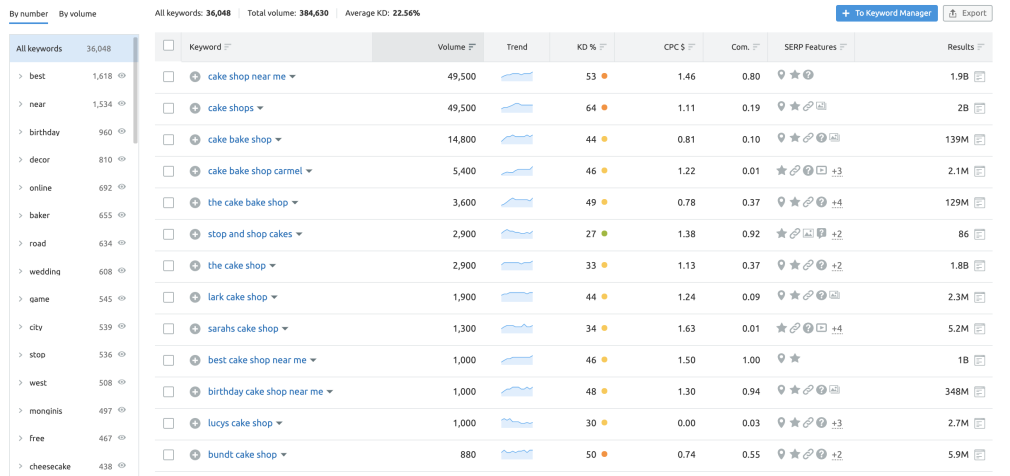
Images are another important element of content optimization. Aim to add at least one image per page. This makes the content more visually attractive and interesting to readers while also showing search engines that the content has value. Image files should be labeled using the image file name and should have the primary keyword as the image alt tag and image title.
It’s also recommended to insert links to high-quality sites with a good ranking throughout your content. Internal links are also helpful. They direct readers to different pages within your website, keeping them engaged.
3. Effective Keywords
Keywords are a critical consideration for on-page optimization. Your content should include target keywords — basically, what words or phrases users might look for that would ideally lead them to your page.
Keywords tell the search engine what your page is about. In addition to a primary keyword for each page, it’s also good to have supporting secondary keywords.
Keywords are also important beyond the actual webpage content. You should create a meta title and meta description for every page, for example. This brief page title and description are listed in the SERP. Again, this is just a quick primer to why keywords matter and how you can make them work for you. Our keyword research tools can help.
Start with our Keyword Overview tool, where you’ll get a comprehensive look at the particular query you’re targeting — including total search volume, how competitive the space is, and key SERP features.
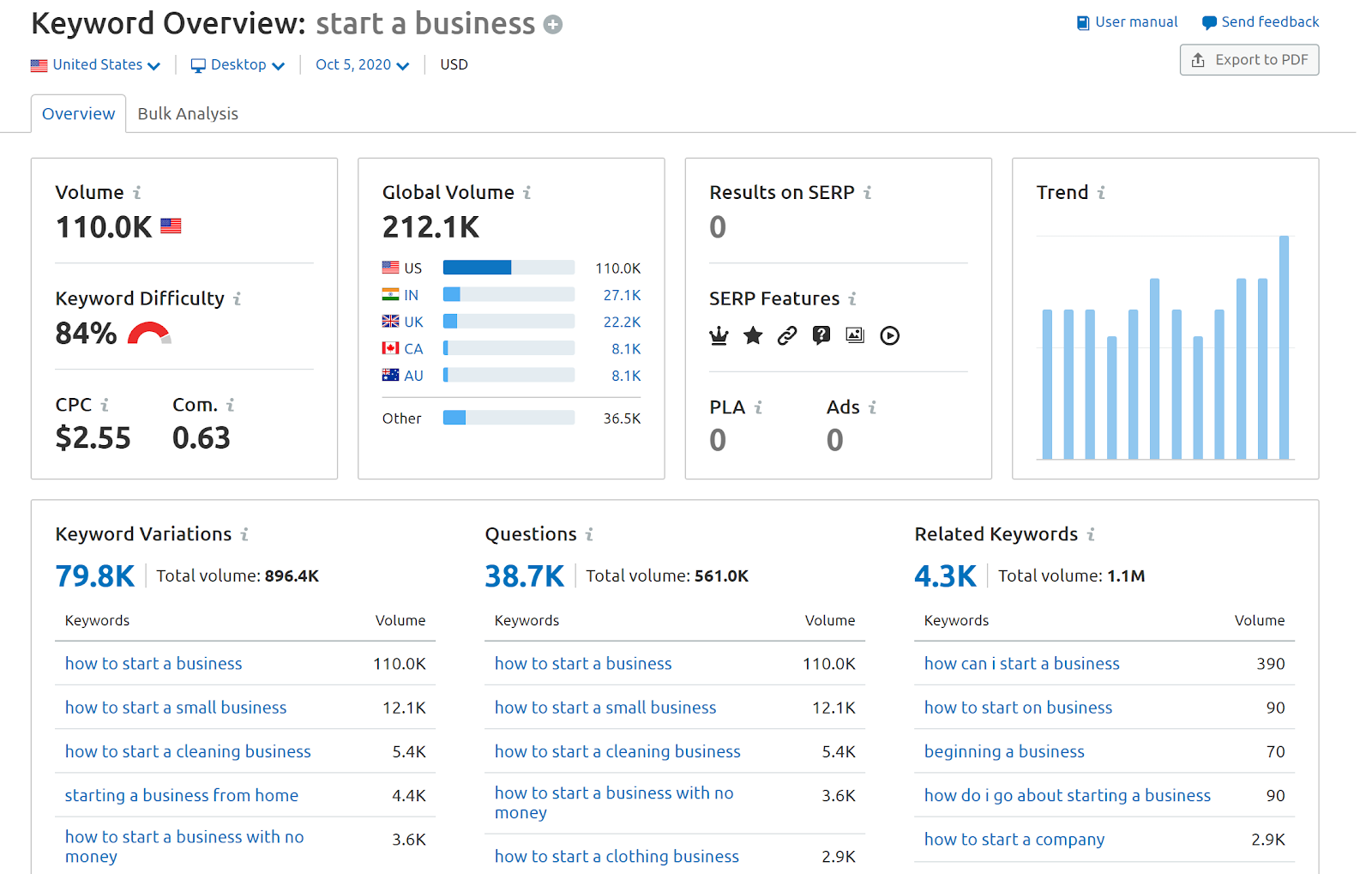
It’s also incredibly helpful when working with the pillar/cluster model for content. You’ll be able to see related keywords with common questions associated with your query. These serve as great jumping-off points when generating future topic clusters and larger pillars related to your initial keyword.
4. Useful Backlinks
Some of the ways to improve your online visibility have nothing to do with what’s on your website, but on other people’s websites. As more and more people are directed to your website from other websites, Google recognizes this and can rank your site higher accordingly. So, how do you drive that traffic?
Backlinks are the answer. These are links on other websites that direct people to your site. When your site is consistently referred to by other quality websites, Google recognizes that it’s trusted. Such backlinks are even more useful if the linking website is trustworthy. Semrush has a whole host of useful tools to analyze your and your competitors' backlink portfolios. You can find some targets through our Backlink Analytics Tool:
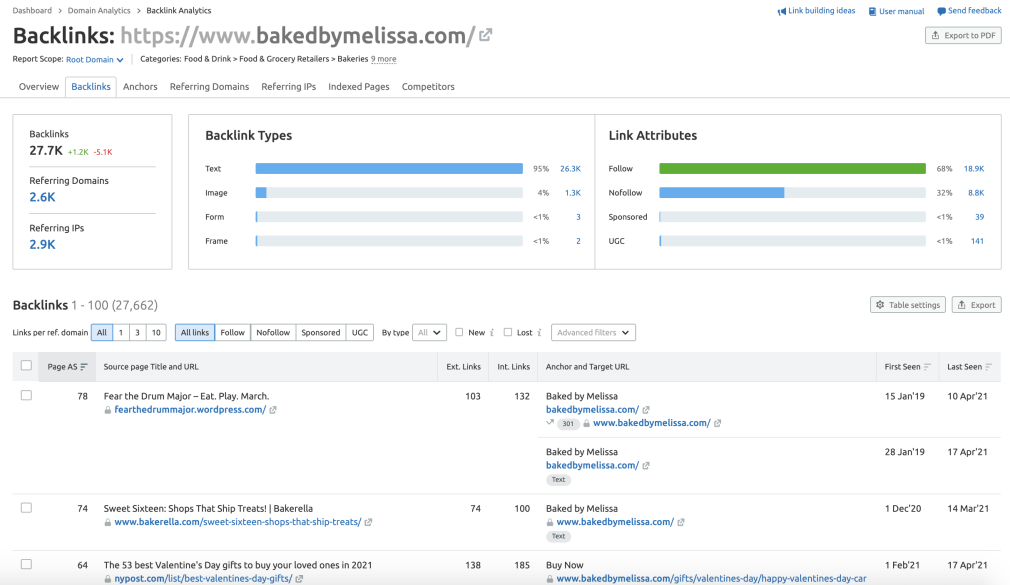
An effective way to generate quality backlinks is to create a compelling infographic and allow other websites and blogs to use it in their content. Users love to share infographics, especially when they have relevant or important data!
Venngage is an easy tool for creating infographics yourself. Craft your visual based on some important statistics or facts relevant to your industry and email it to others in your field, inviting them to share it with their audience. When they publish the infographic, they should include a reference and backlink to you.
5. Security
Fantastic content won’t get you far if your platform is not accessible and secure. You also won’t be able to generate high-quality backlinks if your website isn’t seen as trusted. To ensure your website is secure, use HTTPS encryption. This gives your site SSL certificates, creating a secure connection between your platform and your end-users and protects information that the users might provide to the site, such as passwords.
To ensure your website is accessible, you need it to be well-coded. This makes it easier for Google bots to crawl your pages. Inserting a “robots.txt” file informs bots where they should and shouldn’t look for your site information, for example.
It’s also important to have a sitemap, which includes a list-style overview of all pages. This helps Google understand what your site is about.
6. Crawlability
Crawlability ensures that search engines can find your site. Given that there are billions of webpages live, that’s pretty critical! You want to make it as easy as possible for search engine bots to crawl, index, and understand the type of content you provide.
Crawling refers to the search engine’s process of searching for new or updated webpages. You can check Google Search Console to see how many of your website’s pages Google has crawled.
“Googlebot” is constantly crawling the web, looking for and indexing pages. Some of the most common reasons Googlebot misses sites is that the site is newly launched, the site’s design makes it difficult to crawl effectively, or your policy blocks Googlebot from crawling. You should allow Googlebot to access any CSS, JavaScript, and image files used on your website.
You should also tell Googlebot what pages not to crawl, using a “robots.txt” file. This should be placed in your site’s root directory. Google Search Console even has a “robots.txt” generator you can use.
For instance, Google advises against allowing internal search results pages to be crawled. Why? Users get frustrated if they click a search engine result but end up on a different search engine result on your website.
7. Load Speed
The digital world has come a long way since it first became available to the general public. The days of waiting impatiently for dial-up connections are long gone. Your webpage construction should reflect that.
Top-positioned Google sites average a load time of fewer than 3 seconds. For ecommerce websites, 2 seconds is considered the threshold of acceptability. According to Google webmasters, Google aims for less than a half-second. And with the latest Page Experience Update almost here, it's important to work on improving page speed.
Search engine bots can estimate site speed based on your page’s HTML code. Google also taps into Chrome browser user data to get insights into loading speed. You can do several things to speed up your website, such as minimizing HTTP requests, minifying and combining files, and using asynchronous loading for JavaScript and CSS files.
Server response time is another issue to tackle. A domain name system (DNS) server holds a database of IP addresses. When someone enters a URL into their browser, the DNS server translates that URL to the relevant IP address. It’s like the computer is looking up a number in the phonebook.
Just how long this takes depends on the speed of your DNS provider. Check out DNS speed comparison reports to see how yours stacks up.
8. User Engagement
We’ve talked about the importance of creating quality content and content that is SEO-optimized from a technical standpoint. Your content also has to meet one other criterion: It has to be engaging. Google uses the artificial intelligence tool RankBrain to assess user engagement.
RankBrain looks at elements like click-through rate (how many people click when presented with a search engine result) and dwell time (how much time people spend on a site). For example, if a user visits your website but immediately leaves, this will hurt your site performance (if many people do this to your website, you have a high “bounce rate”).
Creating engaging content is the key to luring people in and keeping them there. Use a clear site architecture that makes it easy for people to navigate. High-quality web design, engaging images, and captivating infographics all help keep people on the page.
9. Schema Markup
Schema markup, or structured data, is a type of back-end microdata that tells Google how the page should be classified and interpreted. This data helps the search engine determine the type of page — for example, is it a recipe or a book chapter? Structured data should be relevant, complete, and location-specific.
Schema.org provides a universal language for structured data. This is all part of your backend site architecture. Say you’re creating a recipe page, your schema markup language might include “@type”:“recipe” and “name”:“The Ultimate Banana Bread Recipe.” This article on structured data markup provides more guidance.
10. Site Authority
A website's authority essentially forecasts how well a website will rank in Google search results. It’s a quick measure of a page’s SEO power potential. Higher-scoring websites are more likely to rank higher in search engines. Semrush provides you with site's Authority Scores within the tool. You can see it here in Domain Overview:
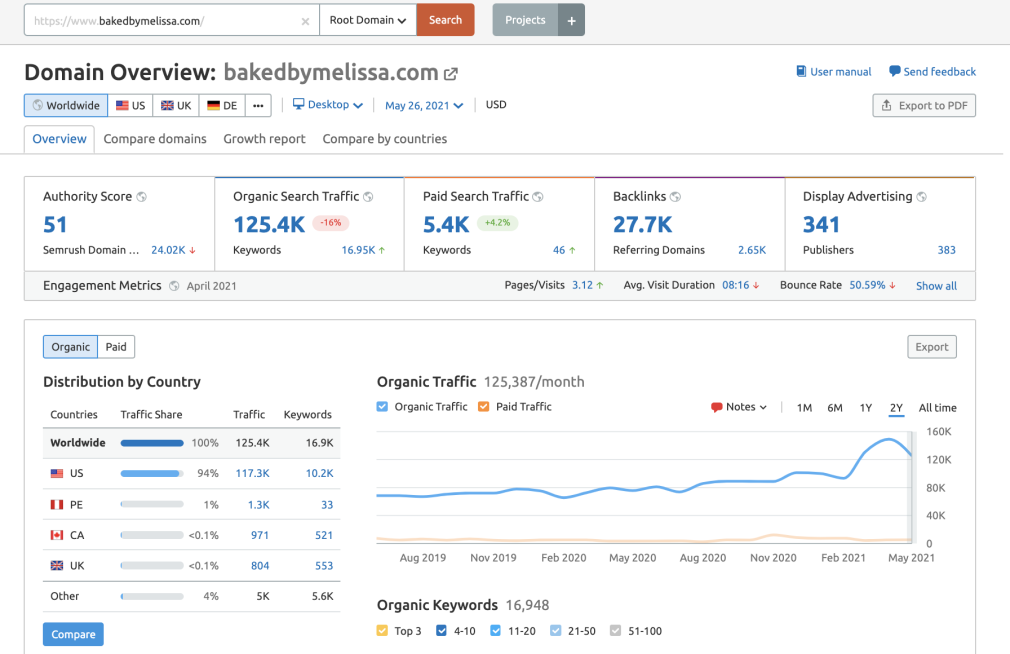
When you register your domain, be aware that it takes time to build up authority. On-page SEO, backlinks, and loading speed are all factors. You basically have to prove yourself to build up high your site's authority score.
Your link profile, which is built through strong backlinks, is something you should be monitoring. You should check your site authority regularly. You can use services like our Backlink Audit Tool to run analytics. Using this tool, you’ll receive not only your website's authority score but also an overall toxicity score ranging from 0 to 100, with 60 to 100 being the most toxic range.
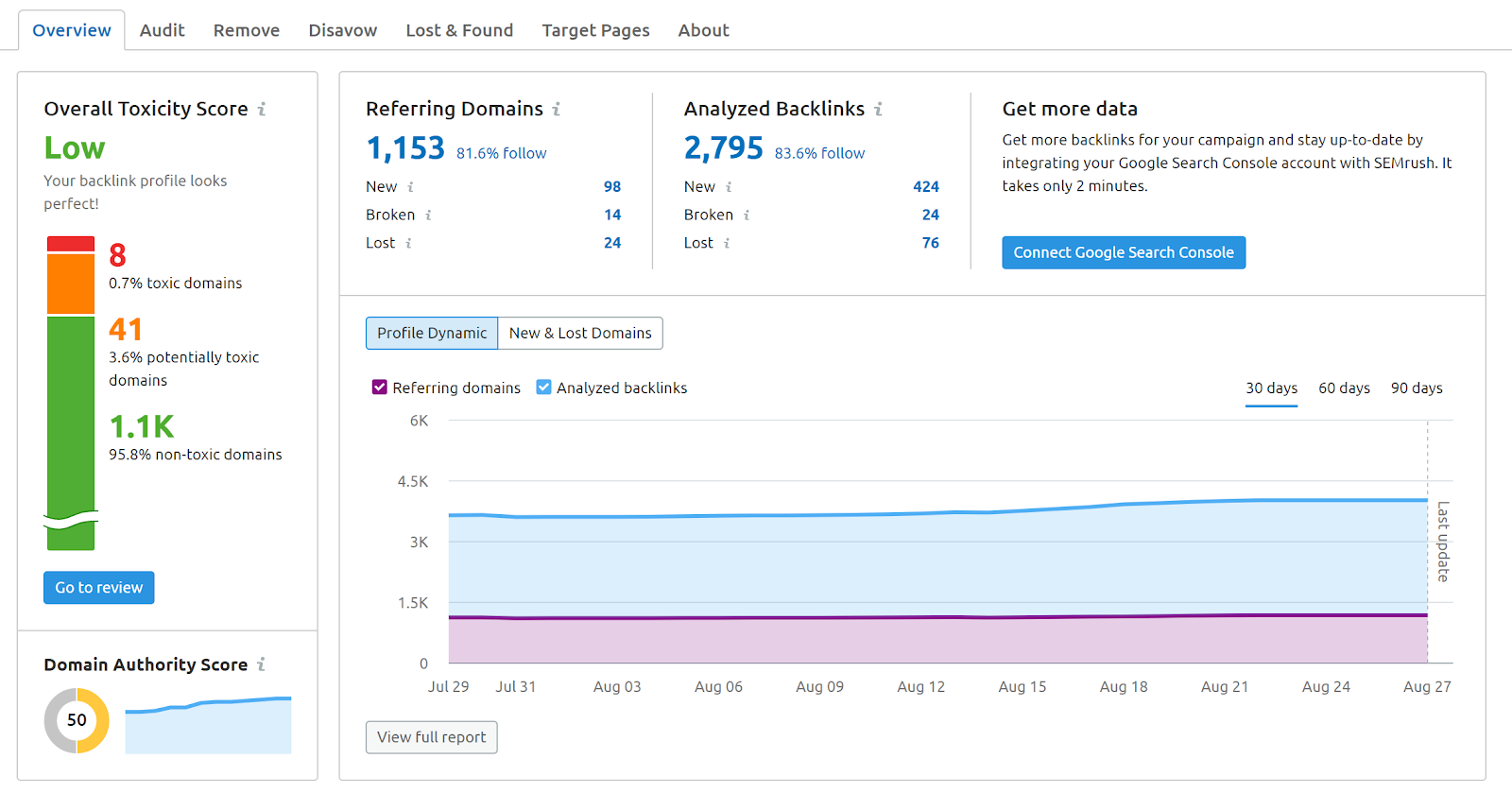
You’ll want to eliminate spammy links or links from low-authority websites, which lower your authority. You can also pinpoint more high-authority real websites for added link building.
11. Mobile-Friendliness
Computers are no longer the gatekeepers of the internet. The majority of all web traffic worldwide is now generated by mobile phones. Recognizing the importance of on-the-go web browsing, Google has explicitly stated that mobile-friendliness is a SERP factor.
Google offers a mobile-friendly test tool that you can use to identify hurdles to mobile usage.
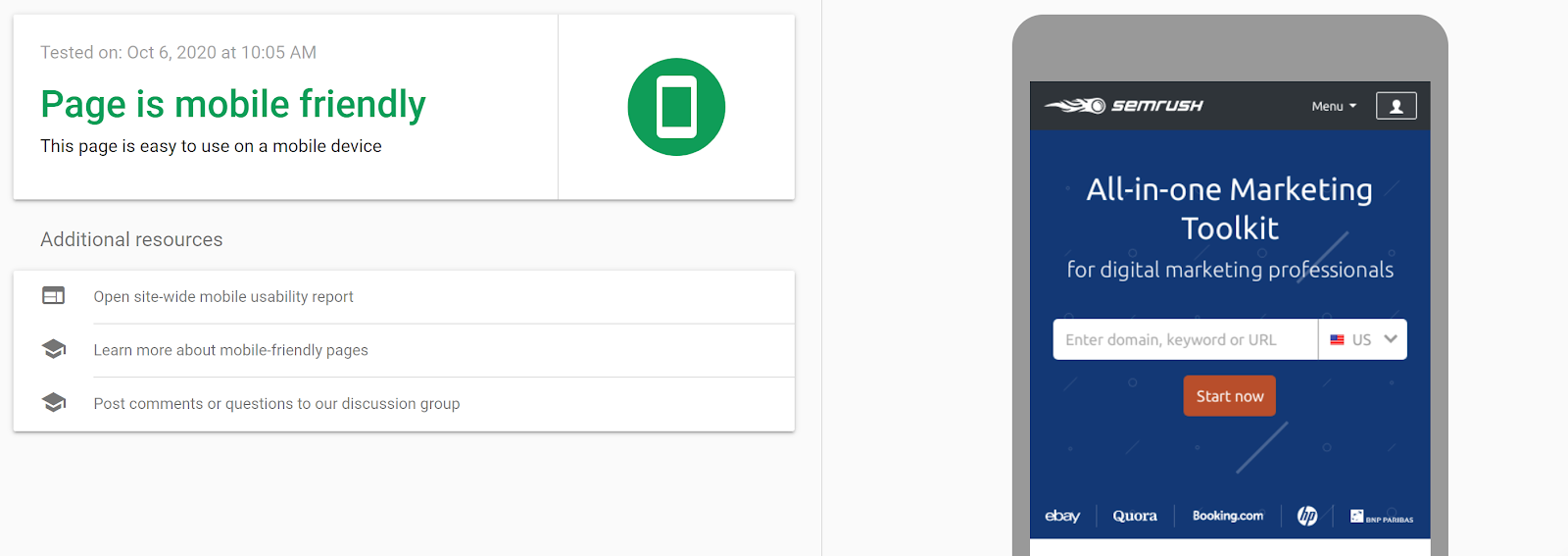
Source: Google Mobile-Friendly Test Tool
You want to create a website that offers a user-friendly experience for both desktop and mobile users—aim for a responsive design, and nix text-blocking ads and pop-ups. Keep mobile design simple. Clutter will look messy on a small screen.
Also, pay attention to details like button size, which needs to be larger on small screens when people use their fingers instead of a tiny mouse pointer to click. Larger fonts are also easier to read on small screens.
12. Reliable Business Listings
Do you remember the reference to EAT in the discussion of high-quality content? Reliable business listings are one piece of the puzzle, especially when it comes to the “T” — trustworthiness. Business listings, also called citations, are especially important at the local level.
Establish a Google My Business page to demonstrate that your organization is real and legitimate. This is connected not only to Google Search but also Google Maps, making it easier for clients to find you online and in the real world.
You can further support your credibility by creating business profiles on industry-related online directories. Also, make sure that the business name and contact information are consistently listed across all of your online profiles.You may, for example, need to merge Google my Business listings if you have more than one.
Our Listing Management Tool can help you monitor your business listing every step of the way. You can ensure that all your information is correct, respond to reviews, and even use it as a local rank tracker tool to see your positions for specific keywords within target areas for your business.
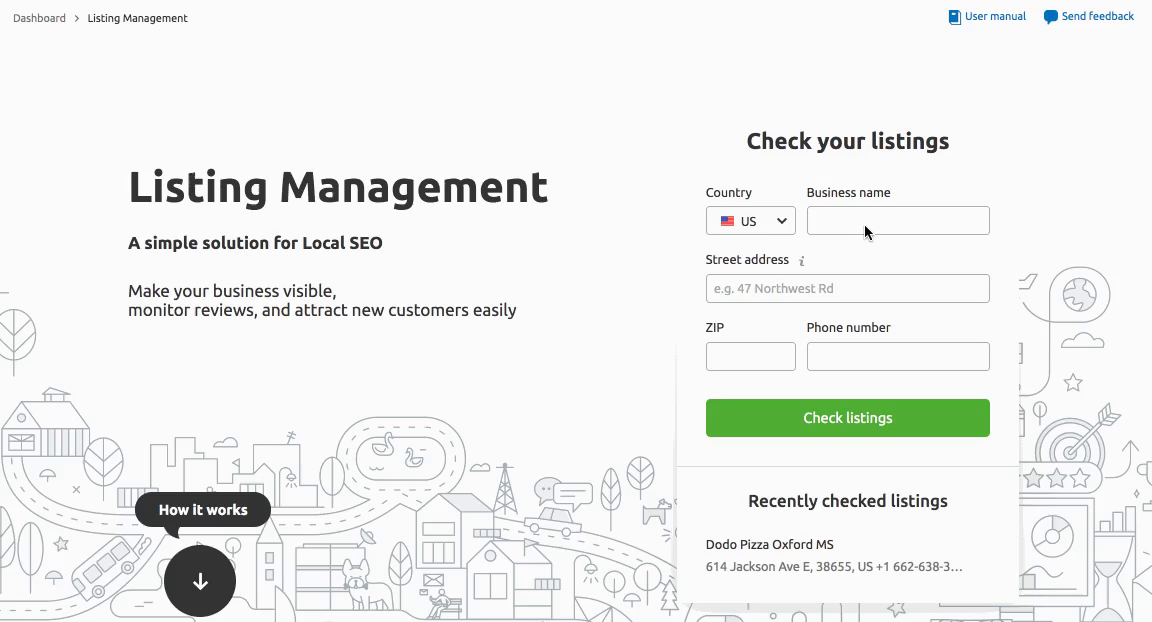
13. Social Media Legitimacy
Getting active on social media is one great way to boost user engagement. Posting links to quality content on Instagram, Facebook, Twitter, etc., gets you clicks and draws in users.
There are upward of 3.6 billion people using social media. That’s a huge audience to reach (and a lot of possible traffic to your page)! Determining which social media platforms to focus on depends largely on your target audience. This demographic breakdown of social media users can help.
Google is paying increased attention to social media accounts in general. For example, buying followers for social media accounts can backfire. A social media account with 100,000 followers, but no interaction looks less legitimate than an account with 10,000 and a lot of active engagement. Google has even filed a patent for technology intended to determine whether social media accounts are real or fake.
Pro tip: To keep your social media profiles running on all cylinders, be sure to check out our Social Media Toolkit which allows you to manage and track your social profiles in one place.
14. Try the Google Snippets Shortcut
One sneaky way to get to the top of search results pages is via snippets. Snippets appear ahead of regular rankings, automatically placing you in the desirable “position zero” of the rankings page even if you aren’t technically “winning” the race.
We’ve included an example below. You can actively target Google snippets with question-inspired content.
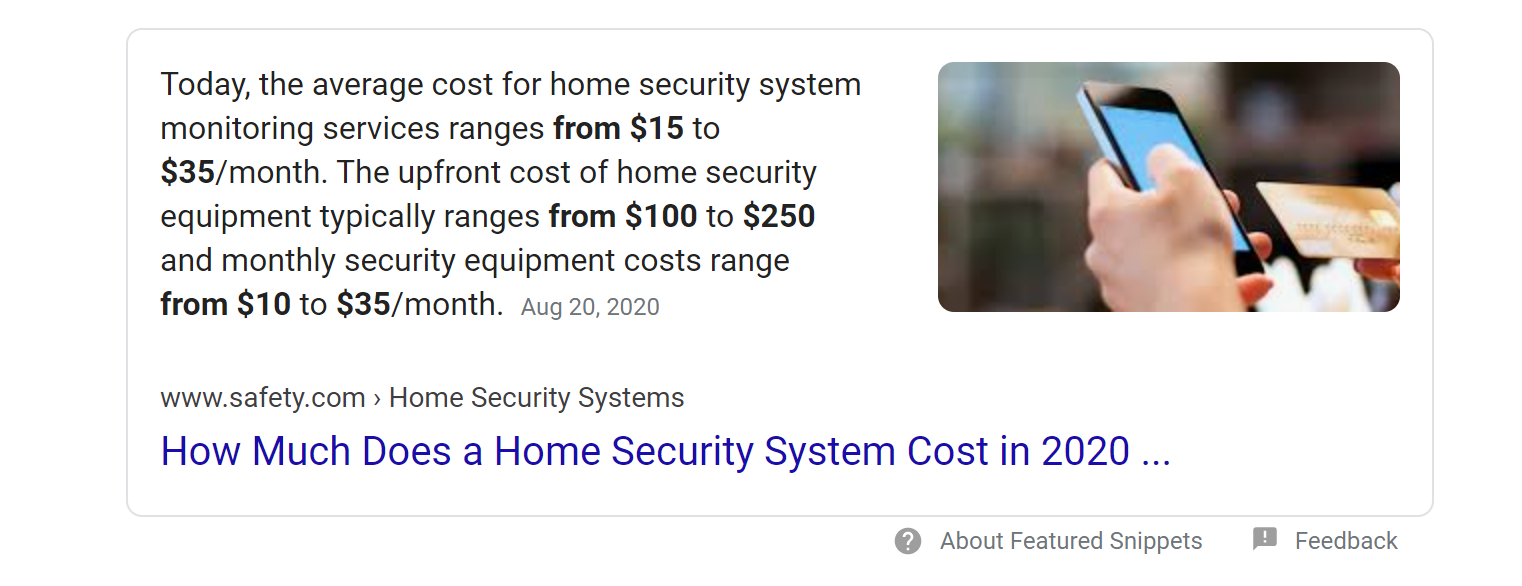
So, think of a common question that people in your niche would ask. If you’re in SEO marketing, for instance, that question might be, “How do you improve your search positions on Google?” Your content should include that phrase as a subtitle and question — and should, of course, answer the question.
Checklist-style content does well in snippets, especially numbered lists. You can find out more about Google snippets here. If you need help finding questions that people are asking, you can use our Keyword Magic Toolto get an idea of a good question you can answer.
15. User-Friendliness
There’s a common thread running through all of the points above, whether they’re related to technical back-end elements or actual visible, front-end content. It’s all about user-friendliness. Many people assume that successful SEO is all about meeting the algorithms of a Google bot.
While it’s technically algorithms that are driving positions, it’s still people who craft those algorithms — and they’re crafting them with the end-user, an actual person, in mind.
From top to bottom, your website needs to prioritize the interests of your target audience. That means addressing tech issues, like loading times, while also crafting compelling content that delivers value to users — all users.
Creating a compliant website with the Americans with Disabilities Act (ADA) can earn you bonus points, for instance. That means including title tags, descriptive alt texts, and proper heading and subheading structure. This is common-sense SEO and also widens the audience you can reach.
Get to the Front Page of Google
The above SEO tips can guide your path to a successful SEO strategy, particularly if you’re just getting started in content marketing and SEO. These tips can only take you so far, however.
A top Google search position takes time, energy, and great attention to detail. Whether you’re looking for support with keyword research or want to track your position, there are many elements to keep in mind. Just remember that SEO is a marathon, not a sprint.
Innovative SEO services
SEO is a patience game; no secret there. We`ll work with you to develop a Search strategy focused on producing increased traffic rankings in as early as 3-months.
A proven Allinclusive. SEO services for measuring, executing, and optimizing for Search Engine success. We say what we do and do what we say.
Our company as Semrush Agency Partner has designed a search engine optimization service that is both ethical and result-driven. We use the latest tools, strategies, and trends to help you move up in the search engines for the right keywords to get noticed by the right audience.
Today, you can schedule a Discovery call with us about your company needs.
Source:





